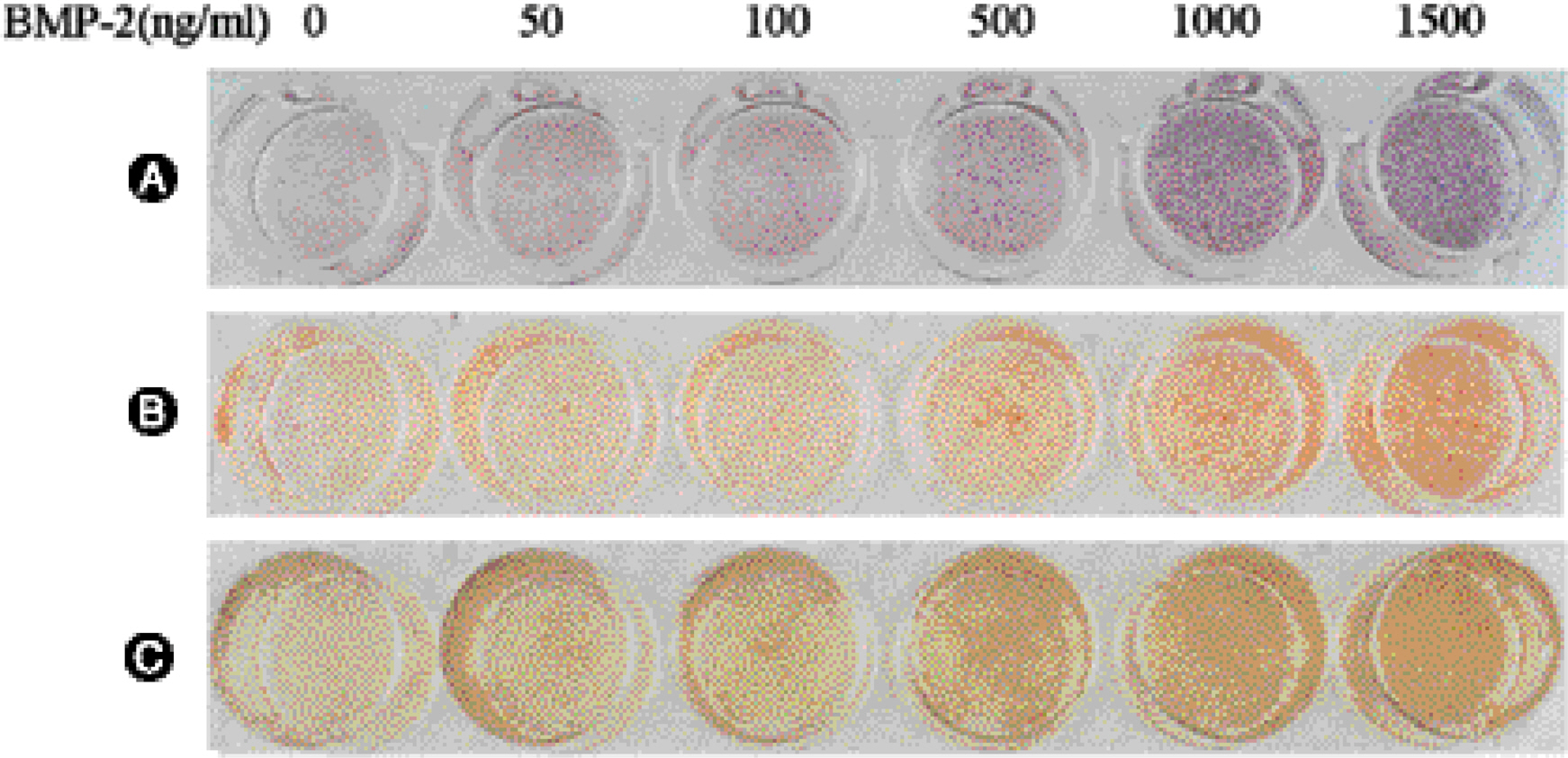J Korean Soc Spine Surg.
2002 Dec;9(4):263-269. 10.4184/jkss.2002.9.4.263.
Osteogenesis by Transfer of Bone Morphogenetic Protein-2 cDNA in Ligamentum Flavum Cells: Approach Toward Tissue Engineering
- Affiliations
-
- 1Department of Orthopedic Surgery, Yonsei University, College of Medicine, Seoul, Korea. hwanlee@yumc.yonsei.ac.kr
- KMID: 2209707
- DOI: http://doi.org/10.4184/jkss.2002.9.4.263
Abstract
-
STUDY DESIGN: In-vitro experiment.
OBJECTIVES
To determine the effect of bone morphogenetic protein-2 in the osteogenesis of human ligamentum flavum cells and test the feasibility of gene transfer to these cells. SUMMARY OF LITERATURE REVIEW: Bone morphogenetic protein-2 (BMP-2) is known to be an important factor in the differentiation and maintenance of the osteoblastic phenotype. Tissue engineering for osteogenesis in ligamentum flavum by BMP-2 and gene transfer has not been previously studied.
MATERIALS AND METHODS
Ligmentum flavum cells were harvested and cultured from surgical patients with spinal stenosis. BMP-2 was produced by transfecting pcDNA3.1/Hygro/BMP-2 into CHO cells using Lipofectamine 2000. Adenovirus-lacZ (Ad/lacZ) was also produced, and administered with BMP-2 to cell culture. The expression of lacZ was analyzed by X-gal staining. Bone formation was assessed by alkaline phosphatase, von Kossa, and alizarin Red-S staining, and the expression of osteocalcin was determined immunocytochemically.
RESULTS
Ligamentum flavum cell cultures with Ad/lacZ showed marker gene expression. BMP-2 induced osteogenesis in ligamentum flavum cells as evidenced by alkaline phosphatase, von Kosa, and alizarin Red-S staining. Also, cell culture with BMP-2 showed strong positivity with osteocalcin by immunocytochemistry.
CONCLUSION
BMP-2 more strongly induced the osteogenesis of ligamentum flavum, and also its gene transfer to ligamentum flavum was found to be feasible. These results may open a new era of ligamentum flavum tissue engineering.
Keyword
MeSH Terms
Figure
Cited by 1 articles
-
Dual Roles of Ligamentum Flavum for Spinal Fusion: As an Osteoinductive Agent and Carrier for Ex-vivo Gene Transfer
Seong-Hwan Moon, Hyang Kim, Un-Hye Kwon, Keong-Hee Kim, Hong Ki Youn, Hak-Sun Kim, Soo-Bong Hahn, Hwan-Mo Lee
J Korean Soc Spine Surg. 2003;10(1):1-7. doi: 10.7469/JKSS.2003.10.1.1.
Reference
-
1). Hayashi K, Ishidou Y and Yonemori K. Expression and localization of bone morphogenetic proteins (BMPs) and BMP receptors in ossification of the ligamentum flavum. Bone. 21:23–30. 1997.
Article2). Hoshi K, Amizuka N, Sakou T, Kurokawa T and Ozawa H. Fibroblasts of spinal ligaments pathologically differ -entiate into chondrocytes induced by recombinant human bone morphogenetic protein-2: morphological examinations for ossification of spinal ligaments. Bone. 21:155–62. 1997.3). Israel DI, Nove J, Kerns KM, Moutsatsos IK and Kauf-man RJ. Expression and characterization of bone morphogenetic protein-2 in Chinese hamster ovary cells. Growth Factors. 7:139–50. 1992.
Article4). Mimatsu K, Kishi S, and Hashizume Y. Expe r ime n tal chronic compression on the spinal cord of the rabbit by ectopic bone formation in the ligamentum flavum with bone morphogenetic protein. Spinal Cord. 35:740–6. 1997.5). Saito H, Mimatsu K, Sato K and Hashizume Y. Histopatho -logic and morphometric study of spinal cord lesion in a chronic cord compression model using bone morphogenetic protein in rabbits. Spine. 17:1368–74. 1992.6). Specchia N, Pagnotta A, Gigante A, Logroscino G, and Toesca A. Characterization of cultured human ligamentun flavum cells in lumbar spine stenosis. J Orthop Res. 19:294–300. 2001.7). Takuwa Y, Ohse C, Wang EA, Wozney JM and Yamashita K. Bone morphogenetic protein-2 stimulates alkaline phosphatase activity and collagen synthesis in cultured osteoblastic cells, MC3T3-E1. Biochem Biophys Res Com -mun. 174:96–101. 1991.
Article8). W ang EA, Rosen V, Cordes P, Hewick RM, Kriz MJ, Lux-enberg DP, et al. Purification and characterization of other distinct bone-inducing factors. Proc Natl Acad Sci U S A. 85:9484–8. 1988.9). Wang EA, Rosen V, D’ Alessandro JS, Bauduy M, Cordes P, Harada T, et al. Recombinant human bone morphogenetic protein induces bone formation. Proc Natl Acad Sci U S A. 87:2220–4. 1990.
Article10). Yoshida M, Shima K, Taniguchi Y, Tamaki T and Tana-ka T. Hypertrophied ligamentum flavum in lumbar spinal canal stenosis. Spine. 17:1353–60. 1992.
Article
- Full Text Links
- Actions
-
Cited
- CITED
-
- Close
- Share
- Similar articles
-
- Immunohistochemical Study of the Ligamentum Flavum in the Lumbar Spinal Stenosis
- Dual Roles of Ligamentum Flavum for Spinal Fusion: As an Osteoinductive Agent and Carrier for Ex-vivo Gene Transfer
- Phenotypic Characterization of Ligamentum Flavum Cells from Patients with Ossification of Ligamentum Flavum
- Ligamentum Flavum Cyst of Lumbar Spine: A Case Report and Literature Review
- Gene Therapy for Bone Tissue Engineering




